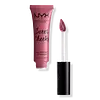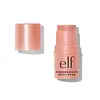NYX Cosmetics Sweet Cheeks Soft Cheek Tint Cream Blush Versus e.l.f. cosmetics Monochromatic Multi Stick
What's inside
What's inside
 Key Ingredients
Key Ingredients

 Benefits
Benefits

No benefits
 Concerns
Concerns

 Ingredients Side-by-side
Ingredients Side-by-side

Dimethicone
EmollientBis-Diglyceryl Polyacyladipate-2
EmollientPhenyl Trimethicone
Skin ConditioningNylon-12
Kaolin
AbrasiveDiisostearyl Malate
EmollientHydrogenated Polyisobutene
EmollientDimethicone Crosspolymer
Emulsion StabilisingVinyl Dimethicone/Methicone Silsesquioxane Crosspolymer
Butyrospermum Parkii Butter
Skin ConditioningGlycerin
HumectantCI 77120
Cosmetic ColorantAlumina
AbrasiveAluminum Hydroxide
EmollientCaprylyl Glycol
EmollientTocopherol
AntioxidantTocopheryl Acetate
AntioxidantSorbic Acid
PreservativePhenoxyethanol
PreservativeCI 15850
Cosmetic ColorantCI 77491
Cosmetic ColorantCI 77492
Cosmetic ColorantCI 77499
Cosmetic ColorantCI 77891
Cosmetic ColorantCI 19140
Cosmetic ColorantCI 42090
Cosmetic ColorantDimethicone, Bis-Diglyceryl Polyacyladipate-2, Phenyl Trimethicone, Nylon-12, Kaolin, Diisostearyl Malate, Hydrogenated Polyisobutene, Dimethicone Crosspolymer, Vinyl Dimethicone/Methicone Silsesquioxane Crosspolymer, Butyrospermum Parkii Butter, Glycerin, CI 77120, Alumina, Aluminum Hydroxide, Caprylyl Glycol, Tocopherol, Tocopheryl Acetate, Sorbic Acid, Phenoxyethanol, CI 15850, CI 77491, CI 77492, CI 77499, CI 77891, CI 19140, CI 42090
Silica
AbrasiveTriethylhexanoin
MaskingDimethicone
EmollientSynthetic Fluorphlogopite
Cetyl Ethylhexanoate
EmollientHydrogenated Polydecene
EmollientSynthetic Wax
AbrasiveIsononyl Isononanoate
EmollientMica
Cosmetic ColorantMicrocrystalline Wax
Emulsion StabilisingSorbitan Sesquiisostearate
EmulsifyingCaprylyl Glycol
EmollientTin Oxide
AbrasiveTocopheryl Acetate
AntioxidantCaesalpinia Sappan Bark Extract
Skin ConditioningCI 77891
Cosmetic ColorantCI 77491
Cosmetic ColorantBlue 1 Lake
Cosmetic ColorantSilica, Triethylhexanoin, Dimethicone, Synthetic Fluorphlogopite, Cetyl Ethylhexanoate, Hydrogenated Polydecene, Synthetic Wax, Isononyl Isononanoate, Mica, Microcrystalline Wax, Sorbitan Sesquiisostearate, Caprylyl Glycol, Tin Oxide, Tocopheryl Acetate, Caesalpinia Sappan Bark Extract, CI 77891, CI 77491, Blue 1 Lake
Ingredients Explained
These ingredients are found in both products.
Ingredients higher up in an ingredient list are typically present in a larger amount.
Caprylyl Glycol is a humectant and emollient, meaning it attracts and preserves moisture.
It is a common ingredient in many products, especially those designed to hydrate skin. The primary benefits are retaining moisture, skin softening, and promoting a healthy skin barrier.
Though Caprylyl Glycol is an alcohol derived from fatty acids, it is not the kind that can dry out skin.
This ingredient is also used as a preservative to extend the life of products. It has slight antimicrobial properties.
Learn more about Caprylyl GlycolCi 77491 is also hydrated iron III oxide. It's sole purpose is to give a red/pink hue to products.
Iron III oxides are classified as inorganic chemicals for coloring.
Synthetically created Ci 77491 is considered safer than those naturally found. This is because the synthetically created version may contain less impurities. Iron oxides are generally non-toxic and non-allergenic.
Learn more about CI 77491Ci 77891 is a white pigment from Titanium dioxide. It is naturally found in minerals such as rutile and ilmenite.
It's main function is to add a white color to cosmetics. It can also be mixed with other colors to create different shades.
Ci 77891 is commonly found in sunscreens due to its ability to block UV rays.
Learn more about CI 77891Dimethicone is a type of synthetic silicone created from natural materials such as quartz.
What it does:
Dimethicone comes in different viscosities:
Depending on the viscosity, dimethicone has different properties.
Ingredients lists don't always show which type is used, so we recommend reaching out to the brand if you have questions about the viscosity.
This ingredient is unlikely to cause irritation because it does not get absorbed into skin. However, people with silicone allergies should be careful about using this ingredient.
Note: Dimethicone may contribute to pilling. This is because it is not oil or water soluble, so pilling may occur when layered with products. When mixed with heavy oils in a formula, the outcome is also quite greasy.
Learn more about DimethiconeTocopheryl Acetate is AKA Vitamin E. It is an antioxidant and protects your skin from free radicals. Free radicals damage the skin by breaking down collagen.
One study found using Tocopheryl Acetate with Vitamin C decreased the number of sunburned cells.
Tocopheryl Acetate is commonly found in both skincare and dietary supplements.
Learn more about Tocopheryl Acetate